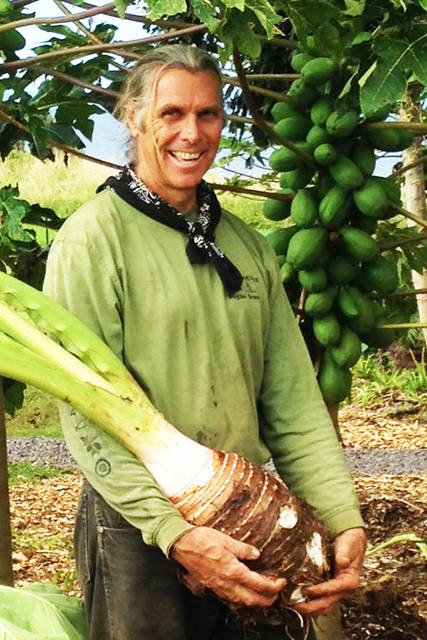Some Hawaii farmers permitted to grow hemp as part of a state research program will harvest their crops soon, but other farmers still have to wait.
The Hawaii Department of Agriculture issued 10 licenses to farmers throughout the state, permitting them to grow hemp. While only four of the licensees have planted their seeds to date, two of them — neither on the Big Island — are planning to harvest within the next few months.
Shelley Choy, coordinator for the department’s Industrial Hemp Pilot Program, said licensees will be permitted to do whatever they want with the harvested crop, provided they do not violate any regulations.
“You can’t market it as medicine or something,” Choy said. “But we don’t regulate what they do with the product.”
Clarence “Cab” Baber, a Hawi farmer whose wife, Gail Baber, was one of the program’s first licensees, said he intends to process their harvest into fiber — which can be used to manufacture textiles, paper, insulation and more — when the first crop becomes mature enough later this year.
“It’s just like any crop; there’s a lot of timing involved,” Clarence Baber said.
Baber said he has been experimenting to determine when the optimal planting time for hemp might be in Hawaii, but expects the first harvest to happen about July. He hopes to stagger his plantings to create a small harvest each month, rather than a single large harvest.
“Our biggest concern is that we can’t exceed the THC standards,” Baber said.
As hemp is a subspecies of cannabis, it must be tested upon harvest to ensure that its concentration of THC — which gives fellow cannabis species marijuana its psychoactive properties — does not exceed 0.3 percent.
Baber said hemp is historically a very strong crop on the Big Island. He referred to early 20th century documents that stated hemp grown on the island was considered “the highest quality in the world.”
However, not all Big Island crops are going well. Another licensee reported that his first planting, in Kona, was wholly destroyed by wild animals, Choy said.
Two other Big Island businesses were issued hemp licenses, most recently Ka‘u farm Earth Matters.
While Baber’s crop is currently relatively small, he hopes to generate plants that are more than 15 feet tall. Choy said the state distributed between six and eight different hemp varietals to licensees, which vary wildly in shape and size, although thanks to a law passed in 2018, licensees are permitted to bring hemp varietals from the mainland as well.
The Agriculture Improvement Act of 2018, among other things, removed hemp from the nation’s list of controlled substances. Despite this, Choy said, hemp remains regulated in Hawaii.
While licensees such as Baber are permitted to grow hemp on a research license, state statutes currently prohibit Hawaii farmers from growing hemp on a commercial license, Choy said.
She went on to say that the state Legislature might revise current hemp statutes to bring them in line with federal standards, but added that such revisions, if passed, likely would not go into effect until at least next year.
Until then, only farmers with research permits are allowed to grow hemp. Those permits expire after two years, but, Choy said, “hopefully, we’ll have commercial permits by then.”
Email Michael Brestovansky at mbrestovansky@hawaiitribune-herald.com.






